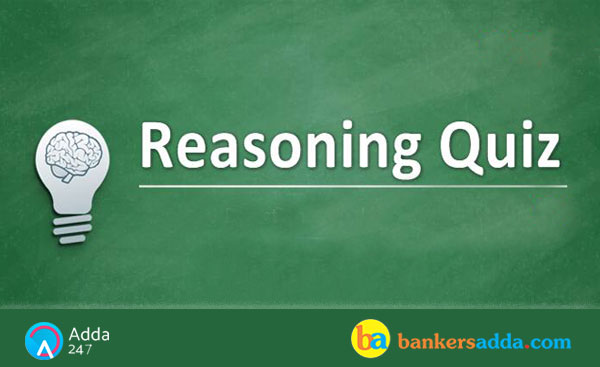
Q1. In a class of 90,where girls are twice that of boys, Rakesh ranked fourteenth from the top ,if there are 10 girls ahead of Rakesh, how many boys are after him in rank?
x+2x = 90 => 3x = 90
x (Boys)= 30 ; 2x(Girls) = 60
Number of student behind Rakesh = 90 – 14 = 76
No of girls behind Rakesh = 60 – 10 = 50
No of boys behind Rakesh = 76 – 50 = 26
Q2. Two cars start from the opposite places of a main road, 150 km apart. First car runs for 25 km and takes a right turn and then runs 15 km. It then turns left and then runs for another 25 km and then takes the direction back to reach the main road. In the meantime, due to minor break down the other car has run only 35 km along the main road. What would be the distance between two cars at this point?
Q3. Q types faster than R but not as fast as V. T types faster than R. S types faster than V. Who amongst the five of them types the fastest?
S>V>Q>R
Direction(4-5): In the following question a statement is given followed by three more course of action numbered as I, II and III. You have to read the course of action and decide which of them follows the given statement.
Q4. Statement: There have been quite a few incidents of highway robbery on the highway between Delhi and Noida during recent months.
Courses of action
I. The local administration should immediately set up police vigilance along the highway to prevent the robbery.
II. The local administration should immediately close down the highway till the robbers are apprehended.
III. More people should be given training on how to tackle the robbers.
Q5. Statement: Company B has rejected the first lot of bolts supplied by company A and has cancelled its entire order quoting the use of inferior quality material.
Courses of action
I. The company A needs to investigate functioning of its purchase, quality and production departments.
II. Company A should inspect all the bolts rejected by company B.
III. Company A should inform company B that steps have been taken for improvement and renegotiate schedule of supply.
Directions (6-10): Study the following information carefully and answer the given question.
In a family there are eight members viz. A, B, C, D, E, F, G and H are sitting around a square table in such a way that four of them sit at four corners of the square while four sit in the middle of each of the four sides. The one who sit at the four corners face the centre of the table while those who sit in the middle of the sides face outside. Each one of them Stay in a different floor viz. 1st, 2nd, 3rd, 4th, 5th, 6th, 7th and 8th. (None of the information given is necessary in the same order).
C sits third to left of the one who Stay on 8th floor. The one who Stay on 8th floor faces outside. Only two people sit between C and H who is grandmother of C. The one who Stays on 1st floor sits to immediate right of H. The one who stays on 5th floor sits second to the right of G who is father of E. G is neither an immediate neighbor of H nor C. G does not stay on 8th floor. Only one person sits between A who is grandfather of D and brother of E, and the one who Stay on 5th floor. C is the father of D. D sits to immediate left of the one who Stays 6th floor. G does not Stay on 6th floor. E Stay on 7th floor. E is not an immediate neighbor of A who is the only brother in law of F. The one who Stay on 2nd floor is an immediate neighbor of E who is son of H. The one who Stay on 4th floor is an immediate neighbour of F. C is a married man. D is a female.
Q6. What is the relation of C with the person who stay on 8th floor?
Q7. Who amongst the following sits diagonally opposite to the one who Stay on 1st floor?
Q8. Who amongst the following represents the immediate neighbour of the one who Stays on 5th floor?
Q9. Who amongst the following sits exactly between H and B when counted in anticlockwise direction with respect to B?
Q10. Which of the following is true regarding B?
Directions (11-15): In each of the following questions assuming the given statements to be true, find out which of the two conclusions I and II given below them is/are definitely true. Give answer
Q11. Statements : V ≤ S, S < L, L< J
Conclusions:
I. V< L
II. S < J
I.V<L(True) II. S<J(True)
Q12. Statements : M ≤ R, R < J, J ≤ H
Conclusions:
I. M ≤ H
II. R < H
I. M≤H(False) II. R<H(True)
Q13. Statements : H ≥ F, F = G, G > M
Conclusions:
I. H > M
II. H > G
I. H>M(True) II. H>G(False)
Q14. Statements : R < J, J > T, T ≤ L
Conclusions:
I. R = T
II. J = L
Q15. Statements : W = T, T ≥ K, K > F
Conclusions:
I. W ≥ K
II. W = K
I.W≥K(True) II. W=K(False)





 The Hindu Review October 2022: Download ...
The Hindu Review October 2022: Download ...
 RBI JE Cut Off 2025, Check Previous Year...
RBI JE Cut Off 2025, Check Previous Year...
 Best Mock Test For SBI Clerk 2024-25 Exa...
Best Mock Test For SBI Clerk 2024-25 Exa...




